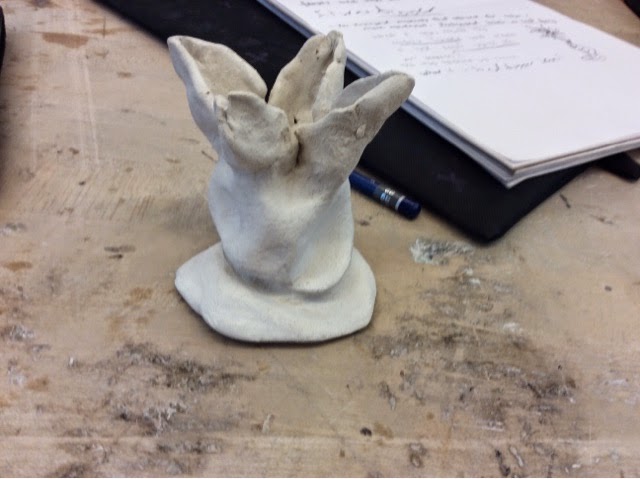Friday, October 23, 2015
Artist Choice Blog
Monday, October 19, 2015
BEAM Project
Wednesday, June 10, 2015
Year In Review
Friday, June 5, 2015
Carving project
Monday, May 18, 2015
Final Value project
ON CHARCOAL DRAWING
Placing the light on the page by erasing the dark away was very unique, and I found this to represent the value more than on a photograph because you could place exactly where the light was, and maybe exaggerate it in some parts. Techniques such as only erasing where the light actually hits and not outlining the objects allowed me to better represent the value. Working with charcoal made representing the value easier to accomplish because you can lightly erase the charcoal to get many grays or erase it all the way to get sold blacks and whites. The one downside with charcoal(besides being messy) is that it is hard to control exactly where you want your values because erasing isn't very precise.
I stretched and explored because I didn't have many different values in the beginning, but added a variety of more because of the eraser-pencil and white pencil that were introduced to us, which allowed to have very solid whites in some places. I also did not have the value of the cloth behind the objects in the beginning but later added it because I learned how to show a flow of value and represent that in the cloth.
If I had to change one thing, I would have started out by lightly erasing where I wanted the values to be and not just adding them on over time, it would help with an overall view of the final product.
ON VALUE in Drawing & Photography
Light and contrast were very important to both projects, but I feel more so in the charcoal project, which I also found the most success in, because you are physically placing the light on the page instead of just capturing it. This allowed for more expressive values because you could slightly modify where the light was actually hitting to have more values and show more light, unlike in photography where it was much more difficult to do this.
Value is very important to pay attention to because lighting can change the mood of an entire piece. Art that is dark and contains almost no light sets a scary and mysterious mood where as very vibrant picture with lots o white sets a happy or excited mood on the piece.
Thursday, April 23, 2015
Value Project
Monday, March 23, 2015
All three projects
I used the form and texture from your previous projects and took those and usde them in your new project. I looked at my previous pieces' form and textures and displayed them in my second sculpture. Although I used many of previously used forms, I explored with sticks and tying them down to create a new form. My second form sculpture was the most technical with string tying it down. The clay sculpture connected with both of my other projects, having leaves from my texture block and the form and flow of my second sculpture. The texture block was much simpler than the other two and was used a a base for them. The curve of the leaves were represented in my second sculpture while they were literally represented in my clay sculpture. Although I believe my second sculpture is the best because of its technicality, my clay sculpture had elements from both of the other two.
Thursday, March 12, 2015
Greenware blog reflection
a. what excited you about the process of working with clay, of creating a an abstract form focused on texture? what are you most curious about?
Being able to form with a very maluable material such as clay made me excitedly do to use it. I am curious about seeing how the clay will form and bend to make it so I get what I want.
b. if you were to begin the clay sculpture anew, what is the most important piece of advice you would need?
Thursday, March 5, 2015
Clay project
Friday, February 13, 2015
square texture project
Thursday, February 5, 2015
Pop art paintings
1. Describe your intentions (envision)
I chose a stapler as my object because it has flat surfaces but also had many different dimensions/levels. I chose blue as my color because dark blue and light blue compliment each other better than other colors.
2. Describe process: How did you engage and persist toward your goals? How well did you develop craft?
I engaged and persisted towards my goals by following my different shades and made sure I placed them where they were supposed to go. Although some of my edges of my object aren't very clean, I tried to keep the very different colors, such as the dark blue and the light blue, from touching each other and blending.
3. Assess your degree of success based upon your observations (directly of your work and those received from your peers)
I did not use brush strokes very well on my actual object but my background had a good texture and the color of the background allowed for the object to "pop" off the page.






















